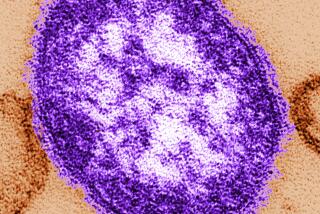LAX Plans for Bird Flu Quarantines
- Share via
Officials at Los Angeles International Airport are racing to devise plans to quarantine hundreds of passengers on the airfield for days to prevent the spread of bird flu.
Federal officials could order travelers on a flight confined, if they suspect that one of them is infected with the deadly disease.
In the last week, airport executives have stepped up planning for the virus, meeting with health agencies to discuss how to handle a potential outbreak. As the nation’s No. 1 gateway for Asian travelers, LAX could be a hot spot if the bird flu were to turn into a form than could pass between humans.
“This is a logistics nightmare,” said Michael DiGirolamo, a deputy executive director for Los Angeles World Airports, who briefed the city’s Airport Commission on Monday.
Twenty-six flights arrive at LAX each day from Asia — more than twice as many as at any other U.S. airport. Every day, up to 10,000 passengers disembark from those aircraft. Aviation officials worry that the bird flu could mimic severe acute respiratory syndrome, or SARS, which journeyed to five countries in 24 hours after emerging in rural China in spring 2003.
The H5N1 strain, which is spread by migrating waterfowl, first appeared in Southeast Asia two years ago. Last week, it was found in birds in Turkey and Romania. Scientists fear that the virus could mutate into a form that could be passed among people, leading to a flu pandemic. So far, it has killed about 60 people who have had direct contact with infected birds.
Airport officials are preparing plans to quarantine up to 1,600 passengers in four locations. They are wrestling with how to shelter and feed them and with how many toilets are needed, as well as whether to use force to keep travelers from leaving. They also are studying who would pay for the costly operation.
“Let’s say we go with inflatable buildings,” said Paul Haney, an airport spokesman. “You can’t just stick them on the ground. There’s got to be a foundation. You have to have electrical out there. You have to get water out there.”
The efforts by the city’s airport agency followed criticism earlier this month from health authorities that California was strikingly under-prepared for a global influenza outbreak.
LAX is no stranger to crisis planning. In spring 2003, health workers at the airport screened scores of people on flights from Asia for SARS symptoms. Ultimately, no individuals with SARS came through LAX and only a single Southwest jetliner was isolated on the tarmac for an hour in April 2003 after a passenger told a flight attendant that he might be infected — a claim later proven false.
But SARS did cause overseas travel and concession revenues at LAX to fall dramatically after carriers canceled dozens of flights from Asia in early 2003.
The fallout prompted officials to establish more detailed plans for health emergencies.
As with all matters at LAX, planning for bird flu involves cooperation among myriad local, state and federal agencies. Passengers, pilots, health authorities and airport operations personnel would have to keep tabs on the virus.
The Centers for Disease Control has advised flight crews to isolate ill passengers on airplanes, provide them with masks, and urge them to practice “cough etiquette” by covering their mouths and disposing of tissues in designated bags.
The pilot is supposed to notify the CDC that a sick traveler is in transit and health officials are supposed to board the plane once it lands.
At LAX, such an aircraft probably would be sent to the remote gates on the western end near the sand dunes.
The ill passenger would be taken to a hospital, while the CDC — which doubled its staff at LAX this year to eight — decided whether to quarantine the rest of the passengers for 48 hours. The city’s airport agency would feed and house travelers, and U.S. Customs and Border Protection officials at the airport would enforce the quarantine.
In a severe case, passengers could be quarantined for seven days or more.
If there were a quarantine, health officials would provide antibiotics to passengers who were seated nearest to the infected traveler and would monitor others for fever or other symptoms.
“We’ve looked at taking these people off airport, but who’s going to want them driving through their community to the Forum?” DiGirolamo said, referring to the arena in Inglewood.
Airport officials expect to have a plan within the month.
The airport also is considering purchasing hand-wash dispensers filled with alcohol-based cleaner and placing them in the U.S. Customs areas in the Tom Bradley International Terminal. The city’s airport agency has also checked its stocks of masks and gloves should security screeners require them to handle travelers’ baggage.
“It could happen in six months, or three years,” DiGirolamo told commissioners. “This is going to be a major effort on our part, but we will be prepared to help the CDC.”
More to Read
Sign up for The Wild
We’ll help you find the best places to hike, bike and run, as well as the perfect silent spots for meditation and yoga.
You may occasionally receive promotional content from the Los Angeles Times.






